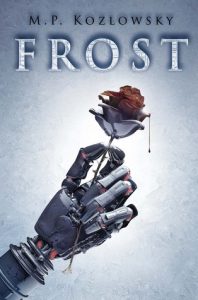Like all good dystopian fiction, Frost by M. P. Kozlowsky begins with a social question that has currency and relevance and then exaggerates the answer to warn society of what could happen if we don’t take the appropriate actions or proceed with caution. Kozlowsky’s plot revolves around wishes for everlasting life–for human immortality–and Dr. Alex Simmelfore has found an answer: Create a robot and download human consciousness to a chip that can be planted into th e robot. These improved robot beings will have human instinct, human thought, and human complexity combined with a body that won’t age, wear down, or succumb to illness.
e robot. These improved robot beings will have human instinct, human thought, and human complexity combined with a body that won’t age, wear down, or succumb to illness.
As readers will suspect, this perfect combination doesn’t exist. Instead, the attempt results in an uprising that produces chaos and ruin. After these Days of Bedlam, when the world is no longer filled with people, color, and the bustle of life but replaced with deterioration, devastation, disease, and other unintended consequences, sixteen-year-old Frost is faced with a decision: In search of hope, security, medicine, and community, does she dare risk the familiar, gutted New York apartment where she has spent her entire life without access to other humans besides her mother, father, and a robot named Bunt?
Frost is driven to reach the blue light of the Battery, a utopian community, where she is convinced she can find the medicine and the science to save her pet, Romes, a large broot with which Frost has formed a deep attachment: “They were linked. [Romes] was her constant companion, her constant comfort, and the one constant source of love in her life” (11).
Despite her limited human contact and despite her knowledge having come mostly from books she has read rather than from actual experiences, Frost sets out on a journey of personal sacrifice and love. In search of medicine, friends, games, parties, music, love, and beauty, Frost encounters Eaters (cannibals), blood-thirsty broots, rogue robots, the terrorist John Lord, and countless other obstacles. On her danger-filled journey, Frost also meets Barrow and Flynn, a father and son who reveal certain truths about Alex Simmelfore, truths that lead Frost to believe that her father’s secrecy went beyond betrayal. Still, their goodness inspires Barrow and Flynn to help Frost. Together, they experience suffering and torture, grief and humiliation, terror and agony. As I read about the undignified and brutal treatment of humans, I grew sick, but people like Esther and her words give readers renewed hope in humanity and in hope’s power. Esther represents the revolutionary and the dreamer in us all; she embodies hope, the “last spark of life” (244).
Besides being genuinely scared about the possibilities this novel proposes, readers can learn from Kozlowsky’s plot, that humans often fear that which is foreign or different, that technology is only as good as those using it, that feelings of superiority have destructive consequences, and that we should not waste what we are given. Frost’s conclusion resonates with Matrix-like surprises and with Ray Bradbury-like predictions and warnings about technology’s potential power! Prepare to be shocked and then to take action!
- Posted by Donna

